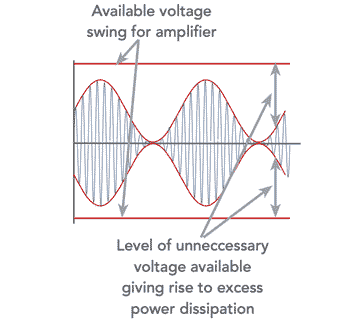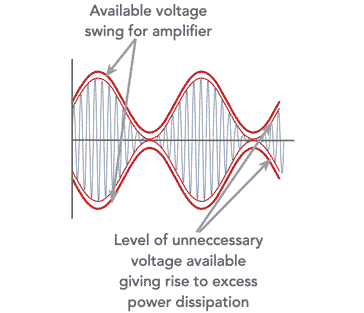What is RF Amplifier Envelope Tracking: A Primer
RF amplifier envelope tracking is an innovative technique to improve the efficiency of RF power amplifiers - it is widely used in smartphones and other applications where amplifier efficiency is key.
Home » Radio & RF technology » this page
Envelope Tracking primer includes:
What is envelope tracking
Block diagram
PSU / DC modulator
Envelope shaping
Control signal
Delay balancing
RF amplifier envelope tracking is a techniques that has been used to improve the efficiency of RF power amplifiers.
Envelope tracking finds applications in many areas where RF power amplifier efficiency is an issue. It has been used on everything from AM broadcast transmitters to areas like cellular communications systems and in particular smartphones.
Envelope tracking provides some significant advantages in terms of minimising the power used in RF amplifiers and this can have a significant impact on battery life if this form of power is used.
In essence envelope tracking systems supply the required supply voltage and no more to the RF power amplifier . In this way power dissipation is reduced.
Video: Envelope tracking primer
Envelope tracking beginnings
Envelope tracking technology was first developed in the 1930s to address the energy problems associated with high power amplitude modulated broadcast transmitters. Loy E Barton described a system for high level modulation in the May 1930 edition of the University of Arkansas Bulletin. The article was the result of several years of work by this little know genius who also invented the class B amplifier.
The idea fell into disuse and was not widely used until the late 1990s when cellular base station manufacturers started to investigate its use with 3G technology. The modulation format used with 3G meant that the RF amplifier efficiency was less than that that could be obtained for 2G systems which predominantly used a form of modulation with no amplitude content. However it took until about 2008 before the first base stations using envelope tracking were launched
The system presented many issues as high modulation bandwidths were required. It was also considered for use within the phones themselves and the first of these phones was launched by Samsung in September 2014, and it is now employed in many smartphones.
RF amplifier efficiency improvement techniques
Over the years there have been several techniques, apart from envelope tracking that have been used to improve the efficiency performance of RF amplifiers. Each of these techniques has its advantages and disadvantages.
| Technology | Basis of Operation | Advantages | Disadvantages |
|---|---|---|---|
| Operate PA in compression | This scheme is only applicable for constant amplitude schemes such as FM and GMSK where there is no amplitude element in the modulation. Can use digital pre-distortion to provide linearity where some amplitude components are available. | • Easy operation where modulation and performance requirements permit. • Provides high efficiency while in compression |
• Does not provide high efficiency for high peak to average power levels signals as amplifier will not run in compression all the time. |
| DC Tracking | The PA voltage is adjusted in line with the modulation level, often using protocol commanded power supply voltage level changes | • Relatively straightforward to implement. • Does not require particularly advanced techniques. |
• Deals only with average power. • Does not address broadband issues. • Does not address instantaneous peaks and troughs. |
| Doherty Amplifier | Amplifier consists of two elements: main amplifier and a peaking amplifier that comes in to assist with peak power levels. The peaking amplifier is biased off for most of the time, only coming into operation for peaks. | • Gives useful increase in efficiency | • Requires combiner for combining output of two amplifier sections. • Gain kinks can occur • Gain and phase vary with output power. |
| Envelope Tracking | Envelope tracking, has the PA supply voltage that tracks the RF envelope. This enables the amplifier to be run at a voltage that gives the optimum efficiency or other performance level at any instantaneous power level. | • Provides best performance at all power levels. • Permits broadband operation. • Provides additional advantages in terms of operation into mismatched loads, etc. . |
• Envelope tracking requires very fast - high bandwidth - power supply. • Requires accurate envelope signal for power supply. |
Each technique has its own advantages and can be used to provide significant benefits under certain scenarios. Envelope tracking is able to offer some significant benefits in terms of efficiency, and general operation for RF power amplifiers used in many applications.
Envelope tracking background
Before looking further into the technology in this envelope tracking tutorial, it is worth looking at the background and need for the techniques like envelope tracking that improve RF amplifier efficiency.
In most RF amplifier applications, the efficiency of the amplifier has an impact on the design, operation and efficiency of the overall system. Power supply requirements, RF amplifier capabilities and heat-sinks are all affected by it. However with the increased use of battery power systems like smartphones, battery power consumption is a particularly important issue.
For any RF amplifier power is supplied to the circuit, and a signal is produced. The output will always be less than the DC input power, the ratio of output to DC input being the efficiency.
The efficiency of an amplifier depends upon the shape of the waveform and the mode in which it is operating.
When operating in a linear mode, the output device must always be in conduction, with the output voltage rising and falling between the two limits.
When operating in this mode, often called Class A, the maximum theoretical efficiency that can be achieved is 50%. However in a real system the achieved levels are always below this.

To achieve better efficiency levels, it is possible to drive the amplifier into compression. Much greater levels of efficiency can be achieved, and if a steady waveform, like FM is used, the only degradation of the signal is that additional harmonics of the fundamental carrier are generated and these can be filtered out using RF filters.
Unfortunately when modulation with an amplitude component is applied to a carrier this is distorted if it is passed through an amplifier that is run in compression.
For data transmission systems that are used today like UMTS, HSPA, and 4G LTE, etc, the RF waveforms that are used incorporate an amplitude component in addition to the phase elements and therefore they require a linear amplifier.
The situation becomes worse as if the peak to average ratio is high, i.e. the waveform has higher peak levels when compared to the average because the amplifier has to be able to accommodate the peaks while still only running at a low average power level.

During the peaks, the amplifier requires the full voltage to be able to deliver the required power without running into compression, but during the periods of lower signal, this voltage is not required and means that power is dissipated in the device. The amplifier only requires a smaller voltage to deliver the lower levels of power and therefore running with the higher voltage all the time, unnecessarily wastes power.

It can be seen that the power dissipated is proportional to the aea between the top of the RF envelope and the rail voltage. For low peak to average power ratio signals, this can be high.
In addition to the modulation, many requirements placed on RF amplifiers used in modern applications such as cellular telecommunications still further reduce the efficiency levels - many amplifiers are required to operate over wide bands, or multiple frequency bands for example.
Envelope tracking: basic concept
In order to improve the efficiency levels of RF amplifiers, one of the approaches that can be used is to employ envelope tracking technology.
As the name indicates, envelope tracking employs a system whereby the amplitude envelope of the signal is tracked and utilised by the amplifier.
Using envelope tracking the power supply voltage applied to the power amplifier is constantly adjusted to ensure that the amplifier is operating at peak efficiency for the given instantaneous output power requirements.

An envelope tracking systems will take the envelope appearing at the input of the power amplifier and then use this to drive the power supply providing the line voltage for the RF power amplifier. This is modulated to ensure that it correctly tracks the amplitude of the signal.
The supply has to be sufficient to meet the needs of the RF amplifier but little more - tracking the voltage required. It must track the voltage required so that the amplifier does not enter compression and distort the signal.In this way the final amplifier will be able to dissipate much less heat and also consume much less power.
 Written by Ian Poole .
Written by Ian Poole .
Experienced electronics engineer and author.
More Essential Radio Topics:
Radio Signals
Modulation types & techniques
Amplitude modulation
Frequency modulation
OFDM
RF mixing
Phase locked loops
Frequency synthesizers
Passive intermodulation
RF attenuators
RF filters
RF circulator
Radio receiver types
Superhet radio
Receiver selectivity
Receiver sensitivity
Receiver strong signal handling
Receiver dynamic range
Return to Radio topics menu . . .



